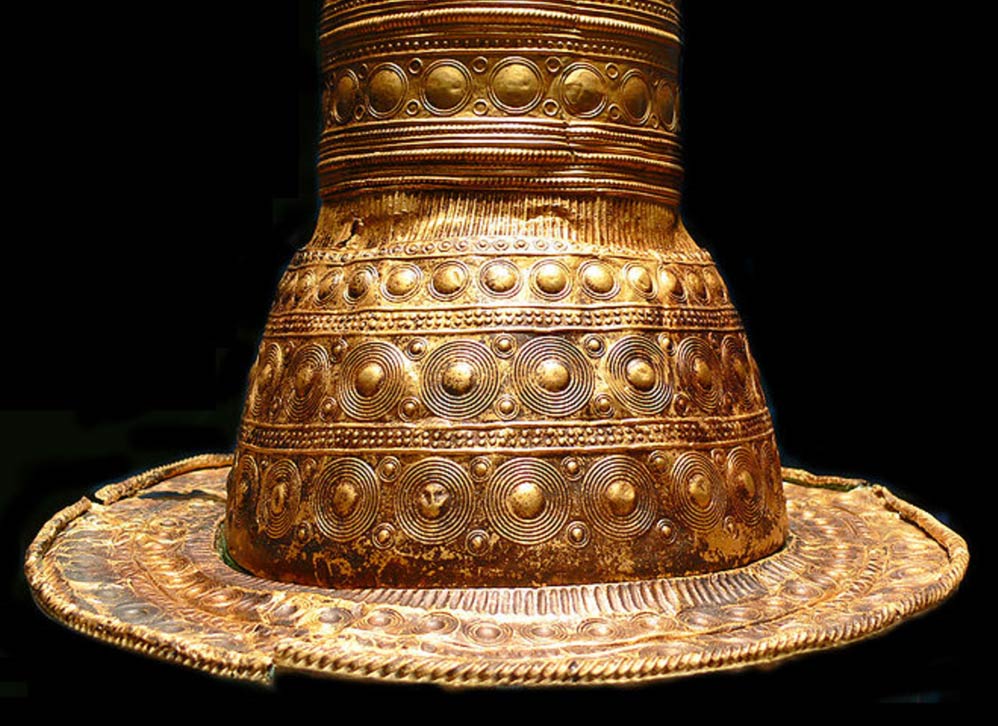
This all requires an underlying bronze shell as could be expected. The gold is laid on in the form of gold leaf. In the examples, this still added up to over ten ounces of gold. This was very impressive anytime in history.
We even have several examples, all decorated in a similar manner.
This completely vindicates the whole spiritual MEME in particular around the Druids. Recall that Jesus took training with them and we have the tradition of his disciples producing a powerful aura. I now wonder if such a hat powers up an adept's aura allowing him to project healing in particular.
Guru Arclein has shared
.
The Mystery of the Four Golden Hats of the Bronze Age
1 February, 2015 - 12:16 mrreese
https://www.ancient-origins.net/artifacts-other-artifacts/mystery-four-golden-hats-bronze-age-002630
The relics and artifacts uncovered throughout the centuries have provided an immense knowledge base about how our ancient ancestors lived, what they believed in, and what skills they had. Occasionally, an astonishing find challenges our understanding of ancient societies and cultures and provides surprising new information about civilizations of the past. One such find, was the discovery of four cone-shaped golden hats from the Bronze Age.
Discovered in different locations and at different times, the four gold hats share many similarities in size, shape, design, and construction. Their conical design mimics the well-known image of a witch’s or wizard’s hat, leading to speculation that the hats were worn by individuals who held such a position. The hats are engraved with symbols that may have been used to make agricultural and/or astronomical predictions, possibly raising the wearer to divine status.
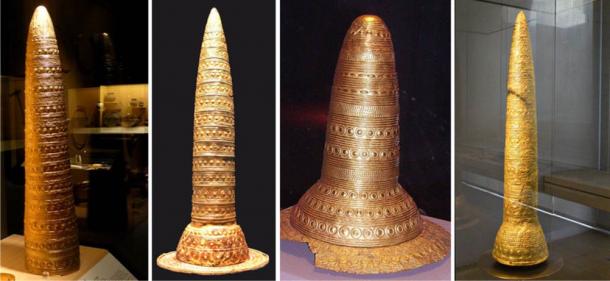
The Four Gold Hats. From Left to Right: Vienne, France (1844); Southern Germany or Switzerland (1996); Schifferstadt, Germany (1835); Ezelsdorf, Germany (1953). Public Domain
The four gold hats are rare archaeological finds dating back to the Bronze Age, which lasted from 3300 – 700 BC. The hats all appear to have been created sometime around the middle of this period, ranging from 1400 – 800 BC. They were each discovered separately, over the course of 160 years, in different locations, three of them in Germany and one in France. There is, of course, the possibility that more gold hats will be uncovered in the future.
The golden relics are constructed of sheets of gold, with intricate astronomical designs and demonstrate superb craftsmanship. While the four hats bear striking similarities, they are also somewhat unique in their specific features.
The first hat was discovered in 1835 at Schifferstadt, Germany. It is called the Golden Hat of Schifferstadt. The Golden Hat of Schifferstadt was uncovered by a farmer, and appeared to have been intentionally buried. It is the shortest of the four hats, standing at 29.6 cm high. It is divided into bands that run the full length of the hat, with each band decorated with one of several designs including circles, disc shapes, and eye-like shapes. The Golden Hat of Schifferstadt is believed to have been manufactured sometime between 1400–1300 BC..
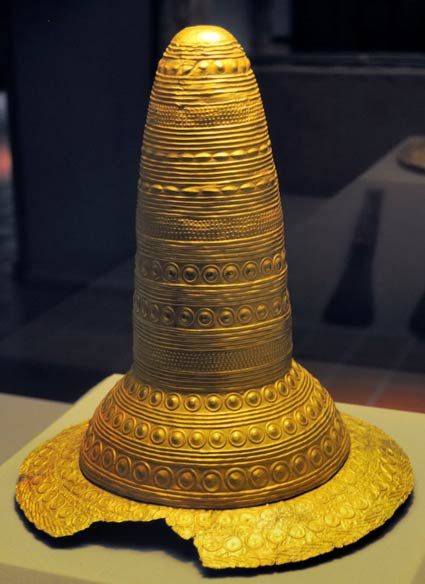
.
The Golden Hat of Schifferstadt ( Wikimedia Commons ).
.
The second hat discovered is the Avanton Gold Cone, discovered in Avanton, France in 1844. The Avanton hat is believed to have been created between 1000-900 BC, and is the only once missing a brim. However, signs of damage indicate that the Avanton hat did have a brim at one point. The cone stands at 55 cm. The Avanton hat is also banded, with repeated circle symbols.
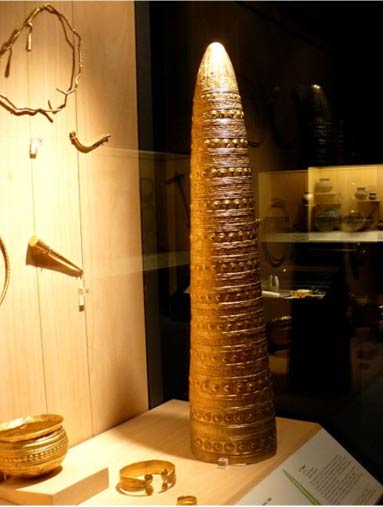
The Avanton Gold Cone ( Wikimedia Commons )
The third hat discovered is the Golden Cone of Ezelsdorf-Buch, discovered near Ezelsdorf, Germany in 1953. The Golden Cone of Ezelsdorf-Buck stands as the tallest of the four hats, at 88 cm tall, and contains the same banded design with repeated circles, discs, and eye-like shapes. It is believed to have originated between 1000-900 BC.
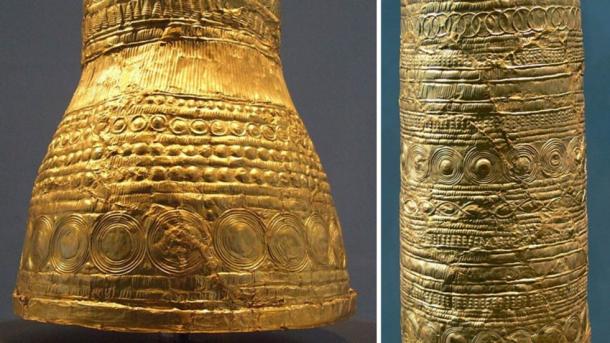
Close-ups of the Golden Cone of Ezelsdorf-Buch, showing the intricate designs carved into the gold sheeting ( Wikimedia Commons )
The provenance of the fourth gold hat is less clear but is believed to have been found in either southern Germany or Switzerland – it was noticed in the international arts trade in 1995. The hat originates from 1000-800 BC, and is known as the Berlin Gold Hat because it was purchased by the Berlin Museum. It stands at 75 cm tall, with the same banded pattern as the others.
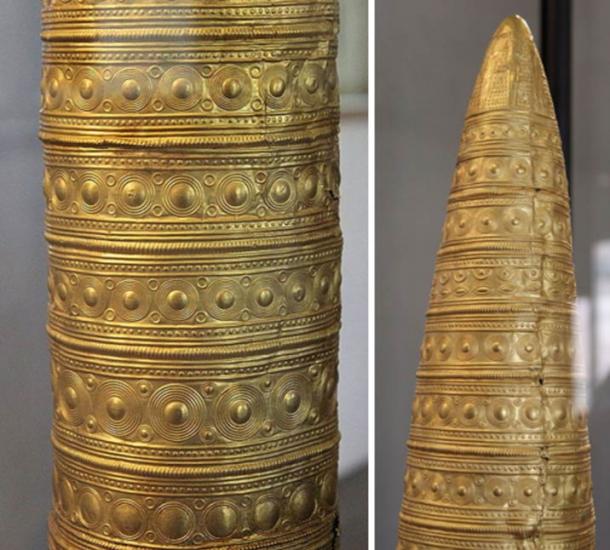
Detail of the Berlin Gold Hat ( Wikimedia Commons )
The purpose of the gold hats is unknown. While they were each found in different areas, speculations have evolved around the hats as a group, under the assumption that they were all used for similar purposes. For some time, the hats were believed to be symbols of fertility, perhaps due to their phallic shape. Researchers once believed that the hats were part of an ancient suit of armor, or that they were used as ceremonial vases. Later, the hats were believed to have been placed upon stakes at sites of worship, to serve as decorative caps. It has also been speculated that the four hats once belonged to ancient wizards, due to their resemblance to wizard-style hats.
As of recently, German archaeologists and historians believe that the hats were, in fact, used by individuals who would have been viewed as ‘wizards’ during the Bronze Age. According to these recent theories, the astrological symbols were used to track the stars and the sun, which allowed for agricultural predictions, namely when to plant and harvest. The figures who wore the hats were referred to as “king-priests.” Because they were able to make predictions and were therefore believed to have supernatural powers. While predictions of time and weather are commonplace today due to modern knowledge and technology, the ability to predict climate conditions during the Bronze Age was seen as a divine power.
Wilfried Menghin, the director of the Berlin Museum, has been extensively studying the hats. According to Menghin, the king-priests “would have been regarded as Lords of Time who had access to a divine knowledge that enabled them to look into the future." According to Menghin, the sun and moon symbols are a match with the “Metonic Cycle,” which provides an explanation of the time relationship between the sun and moon. The knowledge that this pattern provided would have allowed for long-term predictions of sun and moon cycles. Overall, this shows that those who inhabited Europe during the Bronze Age were far more sophisticated than initially believed. It is easy to see how the ability to make such long-term astrological predictions would give one the appearance of having divine or magical powers back in the Bronze Age. Perhaps the idea that the gold hats were worn by ancient wizards isn’t a legend or a myth, but a true reflection of how the wearers were viewed due to their ability to predict time.
The discovery of the four gold hats has provided a fascinating insight into the life and practices of those who lived around three millennia ago. The use of the hats to predict the movements of the sun, and the time relationship between the sun and the moon isn’t entirely novel, as many ancient artifacts indicate much focus on such astrological features. But why they chose to express such knowledge on golden hats is still unclear. Perhaps with further research, we will someday know why the ‘wizards’ of the Bronze Age wore these spectacular hats of gold.
Featured image: Bronze Age Golden Hat (ca. 1000-800 BC.). Collection: Museum of Prehistory and Early History, Berlin ( Wikimedia Commons )
Sources:
Four Gold Hats: A Bronze Age Mystery – Jaunting Jen. Available from: http://jauntingjen.com/2014/01/06/four-gold-hats-a-bronze-age-mystery/
Mysterious gold cones 'hats of ancient wizards' – The Telegraph. Available from: http://www.telegraph.co.uk/news/worldnews/europe/germany/1388038/Mysterious-gold-cones-hats-of-ancient-wizards.html
Golden Hat – Wikipedia. Available from: http://en.wikipedia.org/wiki/Golden_hat
By M R Reese
The relics and artifacts uncovered throughout the centuries have provided an immense knowledge base about how our ancient ancestors lived, what they believed in, and what skills they had. Occasionally, an astonishing find challenges our understanding of ancient societies and cultures and provides surprising new information about civilizations of the past. One such find, was the discovery of four cone-shaped golden hats from the Bronze Age.
Discovered in different locations and at different times, the four gold hats share many similarities in size, shape, design, and construction. Their conical design mimics the well-known image of a witch’s or wizard’s hat, leading to speculation that the hats were worn by individuals who held such a position. The hats are engraved with symbols that may have been used to make agricultural and/or astronomical predictions, possibly raising the wearer to divine status.

The Four Gold Hats. From Left to Right: Vienne, France (1844); Southern Germany or Switzerland (1996); Schifferstadt, Germany (1835); Ezelsdorf, Germany (1953). Public Domain
The four gold hats are rare archaeological finds dating back to the Bronze Age, which lasted from 3300 – 700 BC. The hats all appear to have been created sometime around the middle of this period, ranging from 1400 – 800 BC. They were each discovered separately, over the course of 160 years, in different locations, three of them in Germany and one in France. There is, of course, the possibility that more gold hats will be uncovered in the future.
The golden relics are constructed of sheets of gold, with intricate astronomical designs and demonstrate superb craftsmanship. While the four hats bear striking similarities, they are also somewhat unique in their specific features.
The first hat was discovered in 1835 at Schifferstadt, Germany. It is called the Golden Hat of Schifferstadt. The Golden Hat of Schifferstadt was uncovered by a farmer, and appeared to have been intentionally buried. It is the shortest of the four hats, standing at 29.6 cm high. It is divided into bands that run the full length of the hat, with each band decorated with one of several designs including circles, disc shapes, and eye-like shapes. The Golden Hat of Schifferstadt is believed to have been manufactured sometime between 1400–1300 BC..

.
The Golden Hat of Schifferstadt ( Wikimedia Commons ).
.
The second hat discovered is the Avanton Gold Cone, discovered in Avanton, France in 1844. The Avanton hat is believed to have been created between 1000-900 BC, and is the only once missing a brim. However, signs of damage indicate that the Avanton hat did have a brim at one point. The cone stands at 55 cm. The Avanton hat is also banded, with repeated circle symbols.

The Avanton Gold Cone ( Wikimedia Commons )
The third hat discovered is the Golden Cone of Ezelsdorf-Buch, discovered near Ezelsdorf, Germany in 1953. The Golden Cone of Ezelsdorf-Buck stands as the tallest of the four hats, at 88 cm tall, and contains the same banded design with repeated circles, discs, and eye-like shapes. It is believed to have originated between 1000-900 BC.

Close-ups of the Golden Cone of Ezelsdorf-Buch, showing the intricate designs carved into the gold sheeting ( Wikimedia Commons )
The provenance of the fourth gold hat is less clear but is believed to have been found in either southern Germany or Switzerland – it was noticed in the international arts trade in 1995. The hat originates from 1000-800 BC, and is known as the Berlin Gold Hat because it was purchased by the Berlin Museum. It stands at 75 cm tall, with the same banded pattern as the others.

Detail of the Berlin Gold Hat ( Wikimedia Commons )
The purpose of the gold hats is unknown. While they were each found in different areas, speculations have evolved around the hats as a group, under the assumption that they were all used for similar purposes. For some time, the hats were believed to be symbols of fertility, perhaps due to their phallic shape. Researchers once believed that the hats were part of an ancient suit of armor, or that they were used as ceremonial vases. Later, the hats were believed to have been placed upon stakes at sites of worship, to serve as decorative caps. It has also been speculated that the four hats once belonged to ancient wizards, due to their resemblance to wizard-style hats.
As of recently, German archaeologists and historians believe that the hats were, in fact, used by individuals who would have been viewed as ‘wizards’ during the Bronze Age. According to these recent theories, the astrological symbols were used to track the stars and the sun, which allowed for agricultural predictions, namely when to plant and harvest. The figures who wore the hats were referred to as “king-priests.” Because they were able to make predictions and were therefore believed to have supernatural powers. While predictions of time and weather are commonplace today due to modern knowledge and technology, the ability to predict climate conditions during the Bronze Age was seen as a divine power.
Wilfried Menghin, the director of the Berlin Museum, has been extensively studying the hats. According to Menghin, the king-priests “would have been regarded as Lords of Time who had access to a divine knowledge that enabled them to look into the future." According to Menghin, the sun and moon symbols are a match with the “Metonic Cycle,” which provides an explanation of the time relationship between the sun and moon. The knowledge that this pattern provided would have allowed for long-term predictions of sun and moon cycles. Overall, this shows that those who inhabited Europe during the Bronze Age were far more sophisticated than initially believed. It is easy to see how the ability to make such long-term astrological predictions would give one the appearance of having divine or magical powers back in the Bronze Age. Perhaps the idea that the gold hats were worn by ancient wizards isn’t a legend or a myth, but a true reflection of how the wearers were viewed due to their ability to predict time.
The discovery of the four gold hats has provided a fascinating insight into the life and practices of those who lived around three millennia ago. The use of the hats to predict the movements of the sun, and the time relationship between the sun and the moon isn’t entirely novel, as many ancient artifacts indicate much focus on such astrological features. But why they chose to express such knowledge on golden hats is still unclear. Perhaps with further research, we will someday know why the ‘wizards’ of the Bronze Age wore these spectacular hats of gold.
Featured image: Bronze Age Golden Hat (ca. 1000-800 BC.). Collection: Museum of Prehistory and Early History, Berlin ( Wikimedia Commons )
Sources:
Four Gold Hats: A Bronze Age Mystery – Jaunting Jen. Available from: http://jauntingjen.com/2014/01/06/four-gold-hats-a-bronze-age-mystery/
Mysterious gold cones 'hats of ancient wizards' – The Telegraph. Available from: http://www.telegraph.co.uk/news/worldnews/europe/germany/1388038/Mysterious-gold-cones-hats-of-ancient-wizards.html
Golden Hat – Wikipedia. Available from: http://en.wikipedia.org/wiki/Golden_hat
By M R Reese
No comments:
Post a Comment